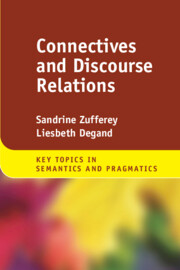Book contents
- Connectives and Discourse Relations
- Key Topics in Semantics and Pragmatics
- Connectives and Discourse Relations
- Copyright page
- Contents
- Figures
- Tables
- 1 Defining Connectives and Discourse Relations
- 2 Theoretical Models of Discourse Relations
- 3 Connectives: Meanings and Functions
- 4 Connectives between Syntax and Discourse
- 5 The Evolution of Connectives’ Meanings
- 6 Processing and Understanding Discourse Relations and Connectives
- 7 Discourse Relations and Connectives across Languages and Genres
- 8 Acquiring Connectives in a First Language
- 9 Mastering Connectives in a Second Language
- Conclusion
- Glossary
- References
- Index
- References
2 - Theoretical Models of Discourse Relations
Published online by Cambridge University Press: 22 February 2024
- Connectives and Discourse Relations
- Key Topics in Semantics and Pragmatics
- Connectives and Discourse Relations
- Copyright page
- Contents
- Figures
- Tables
- 1 Defining Connectives and Discourse Relations
- 2 Theoretical Models of Discourse Relations
- 3 Connectives: Meanings and Functions
- 4 Connectives between Syntax and Discourse
- 5 The Evolution of Connectives’ Meanings
- 6 Processing and Understanding Discourse Relations and Connectives
- 7 Discourse Relations and Connectives across Languages and Genres
- 8 Acquiring Connectives in a First Language
- 9 Mastering Connectives in a Second Language
- Conclusion
- Glossary
- References
- Index
- References
Summary
In this chapter, our main objective is to provide a succinct description of four leading models of discourse: Rhetorical Structure Theory, Segmented Discourse Representation Theory, the Penn Discourse Treebank project, and the Cognitive approach to Coherence Relations. We present the main goals of each model, and discuss their advantages and limitations. We also list their specificities compared to other models, and analyze the main differences between them. We focus more specifically on the aspects of these models that have to do with the description of discourse relations. For each model, we present the type of research to which it has been applied, and the data that have been produced in the form of annotated corpora. As we will see, all these models have been used to annotate large corpora with discourse relations. An important issue is therefore to establish mappings between the relations annotated in each of them, in order to compare data from one corpus to the others. At the end the chapter, we discuss various options for comparing annotations across models.
Keywords
- Type
- Chapter
- Information
- Connectives and Discourse Relations , pp. 23 - 47Publisher: Cambridge University PressPrint publication year: 2024

